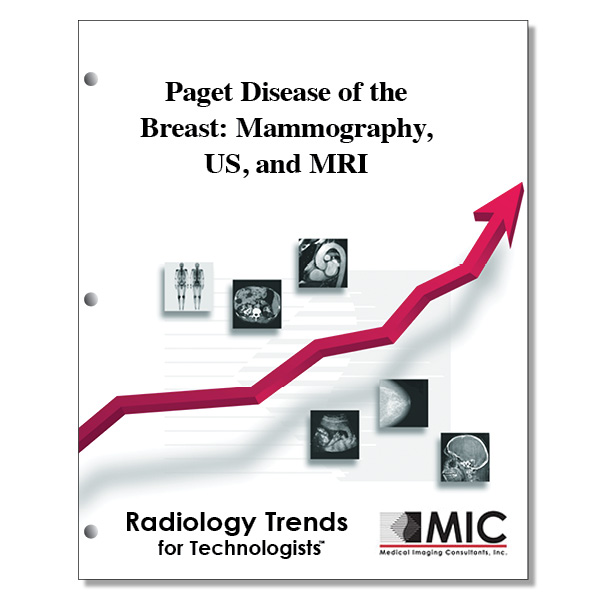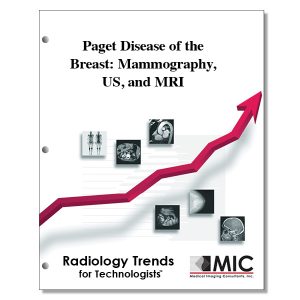

Paget Disease of the Breast: Mammography, US, and MRI
Clinical manifestations and imaging findings of Paget Disease at mammography, US and MR imaging are presented.
Course ID: Q00356 Category: Radiology Trends for Technologists Modalities: Mammography, MRI, Nuclear Medicine, Sonography2.75 |
Satisfaction Guarantee |
$29.00
- Targeted CE
- Outline
- Objectives
Targeted CE per ARRT’s Discipline, Category, and Subcategory classification:
[Note: Discipline-specific Targeted CE credits may be less than the total Category A credits approved for this course.]
Breast Sonography: 2.75
Patient Care: 0.25
Patient Interactions and Management: 0.25
Image Production: 0.50
Evaluation and Selection of Representative Images: 0.50
Procedures: 2.00
Anatomy and Physiology: 0.50
Pathology: 1.25
Breast Interventions: 0.25
Mammography: 2.75
Patient Care: 0.25
Patient Interactions and Management: 0.25
Procedures: 2.50
Anatomy, Physiology, and Pathology: 1.75
Mammographic Positioning, Special Needs, and Imaging Procedures: 0.75
Magnetic Resonance Imaging: 1.75
Procedures: 1.75
Body: 1.75
Nuclear Medicine Technology: 1.75
Procedures: 1.75
Endocrine and Oncology Procedures: 1.75
Registered Radiologist Assistant: 2.75
Procedures: 2.75
Thoracic Section: 2.75
Sonography: 1.75
Procedures: 1.75
Superficial Structures and Other Sonographic Procedures: 1.75
Radiation Therapy: 2.75
Patient Care: 1.00
Patient and Medical Record Management: 1.00
Procedures: 1.75
Treatment Sites and Tumors: 1.75
Outline
- Introduction
- Histopathologic Features
- Pathogenesis
- Clinical Manifestations
- Differential Diagnosis of Nipple Changes
- Classification
- Diagnosis
- Mammography
- Ultrasonography
- MR Imaging
- Management
- Conclusions
Objectives
Upon completion of this course, students will:
- know the importance of associated underlying breast cancer with Paget disease of the nipple/breast
- understand the likelihood of occurrence of invasive (advanced) cancer occurring with PDB
- know the importance of using the appropriate procedures to demonstrate occult cancer
- recognize the histologic appearance of Paget Cells
- know the histologic features of Paget cells
- understand the theory of the pathogenic pathway of Paget Disease
- understand the rationale of the epidermotropic theory of Paget disease
- be able to describe the theory of epidermotropic theory of Paget disease
- understand the intraepidermal transformation theory of pathogenesis of Paget disease
- know the factors that support this theory
- understand the importance of skin changes around the nipple with PDB
- know the significance of nipple changes with PDB
- know the risk of cancer associated with PDB
- understand the importance of the presence of a mass which is suspicious of cancer
- recognize that the associated cancer with PDB is often advanced
- recognize that there are differences between benign eczema and PD of the nipple
- know that steroids may be used as treatment for both benign eczema and Paget disease
- select the appropriate procedure for accurate diagnosis of either Bowen’s or Paget Disease
- select the appropriate examination for diagnosis of nipple changes
- know the importance of the incidence of cancer with PDB of the nipple
- know the theory that supports this low incidence of PDB of the nipple and cancer
- recognize the most important procedure to diagnose skin involvement
- know the correct choice of imaging for diagnosis
- differentiate between nipple findings and breast parenchymal findings
- recognize the findings in the breast parenchymal tissues
- know the percentage of patients who present with PDB and a normal mammogram
- the reason for using ultrasonography
- know one of the roles of MR imaging for PDB
- know the reasons for using MRI in evaluating patients with PDB
- know one of the roles of MRI for nipple imaging
- know a further indication for the use of MRI for PDB
- know the indication for MRI guided biopsy of the breast with PDB
- know the historic standard of treatment for PDB
- know the factors that affect prognosis after initial diagnosis
- recognize the treatment/management for patients with PDB and advanced (invasive) cancer of the breast
